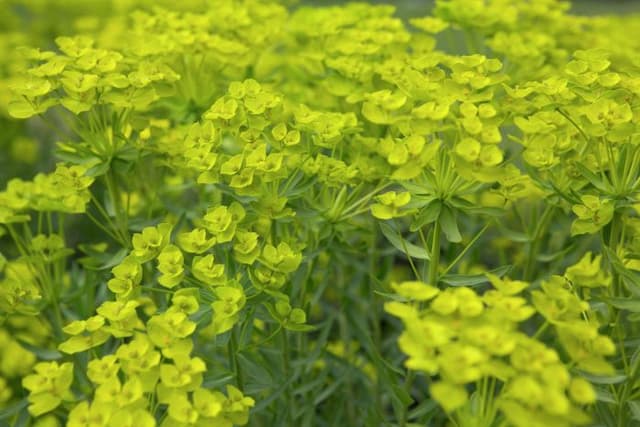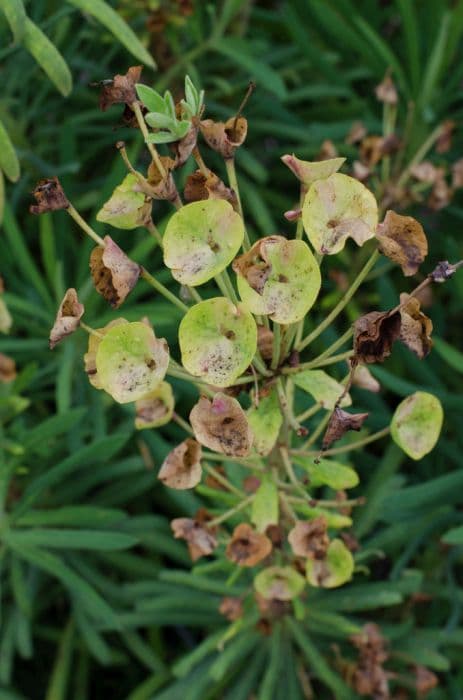Mediterranean Spurge Euphorbia characias subsp. wulfenii 'John Tomlinson'

ABOUT
Euphorbia characias subsp. wulfenii 'John Tomlinson', commonly known as Mediterranean spurge, is a striking evergreen perennial showcasing a robust bushy habit. This plant is characterized by its dense, dome-shaped clusters of tiny, star-shaped flowers that come in a vibrant chartreuse to yellow-green coloration. The flowers are uniquely capped with distinctive, eye-catching purple nectar glands that create a stunning contrast against the bright floral backdrop. The foliage of the Mediterranean spurge is equally attractive, composed of long, narrow leaves that are arranged in a spiral fashion around its thick, upright stems. The leaves boast a handsome blue-green hue which often exhibits a subtle grayish or glaucous tint, adding to its overall textural appeal. These leaves are packed tightly, giving the plant a lush and full appearance. During the blooming period, the colorful flower clusters create a vibrant display, drawing in a variety of pollinators. Overall, the Mediterranean spurge 'John Tomlinson' is a charismatic and hardy plant, with a unique and striking appearance that stands out in any garden setting, making it a personal favorite for gardeners looking to add a touch of drama and color to their landscapes. Its tolerance for a range of conditions and its evergreen nature make it a reliable choice for year-round interest.
About this plant
 Names
NamesFamily
Euphorbiaceae
Synonyms
Mediterranean Spurge, Spurge, Wulfen Spurge
Common names
Euphorbia characias subsp. wulfenii 'John Tomlinson'.
 Toxicity
ToxicityTo humans
Mediterranean Spurge contains a white, milky sap known as latex, which is highly toxic and can cause significant irritation if it comes into contact with skin or mucous membranes. If ingested, the sap can induce severe gastrointestinal distress, resulting in symptoms like nausea, vomiting, and diarrhea. The sap can also be harmful to the eyes and may cause severe eye irritation or damage. In some cases, contact with the skin may lead to allergic reactions, blistering, or inflammation. Due to the toxic nature of the plant, ingesting any part can be dangerous and medical attention should be sought immediately if ingestion is suspected.
To pets
Mediterranean Spurge is toxic to pets due to its latex sap which can be an irritant and contains potent compounds that can cause adverse reactions. If a pet ingests any part of the plant, they might exhibit symptoms such as vomiting, diarrhea, excessive drooling, or difficulty breathing. Additionally, the skin and mucous membranes can be irritated by the sap, leading to redness, swelling, and pain. More severe reactions might occur from ingestion, so it is crucial to prevent pets from accessing this plant and to consult a veterinarian promptly if exposure is suspected.
 Characteristics
CharacteristicsLife cycle
Perennials
Foliage type
Evergreen
Color of leaves
Blue-green
Flower color
Chartreuse
Height
3 feet (0.91 meters)
Spread
3 feet (0.91 meters)
Plant type
Shrub
Hardiness zones
8
Native area
Mediterranean
Benefits
 General Benefits
General Benefits- Drought Tolerance: Mediterranean Spurge can survive in dry conditions, making it suitable for water-wise gardens.
- Low Maintenance: It requires minimal care, with no need for regular watering or pruning once established.
- Architectural Interest: With its distinctive upright growth and cylindrical flower heads, it adds structural interest to garden designs.
- Attracts Pollinators: Its flowers are a valuable source of nectar and pollen for bees and other beneficial insects.
- Deer Resistance: It is generally resistant to grazing by deer, which can be useful in areas where deer predation is a problem.
- Seasonal Interest: Provides year-round interest with evergreen foliage and long-lasting spring blooms.
- Versatility in Landscaping: Can be used in a variety of garden styles, including rock gardens, borders, and Mediterranean-themed landscapes.
- Soil Adaptability: It is adaptable to a range of soil types, though it prefers well-drained soil.
 Medical Properties
Medical PropertiesThis plant is not used for medical purposes.
 Air-purifying Qualities
Air-purifying QualitiesThis plant is not specifically known for air purifying qualities.
 Other Uses
Other Uses- Euphorbia characias 'John Tomlinson' can be used as a natural barrier or hedge due to its size and dense growth habit, providing privacy or delineation in a garden landscape.
- The milky sap of the plant has been traditionally used as a fish poison in some cultures, where it is introduced into small bodies of water to stun or kill fish for easy collection.
- Its structural form and long-lasting blooms make it suitable for dried flower arrangements, adding an architectural element to the composition.
- The robust stems of this euphorbia can be used in crafting, such as for making small stakes or supports for other plants in the garden.
- The unique texture and color of the foliage can be used as a backdrop in macro photography, enhancing the contrast and focus on the subject.
- Gardeners may use the plant as part of a xeriscaping scheme, utilizing its drought-tolerant properties to create a low-water-use garden.
- Its bright green foliage and yellow flowers can be incorporated into a color-themed garden design, providing a vibrant focal point during blooming season.
- Landscape designers may utilize the plant to create a Mediterranean garden ambiance, as it is native to that region and complements other plants from similar climates.
- Euphorbia 'John Tomlinson' can serve as an educational tool in botanical gardens, illustrating the diverse forms and adaptations of plants within the Euphorbiaceae family.
- Artists and illustrators may use the plant as a subject for botanical art, capturing its intricate details and form in various mediums.
Interesting Facts
 Feng Shui
Feng ShuiThe Mediterranean Spurge is not used in Feng Shui practice.
 Zodiac Sign Compitability
Zodiac Sign CompitabilityThe Mediterranean Spurge is not used in astrology practice.
 Plant Symbolism
Plant Symbolism- Resilience: Euphorbia characias, commonly known as Mediterranean Spurge, often symbolizes resilience due to its ability to thrive in poor soils and resist drought conditions.
- Protection: With its toxic sap, the Mediterranean Spurge can represent protection as it deters herbivores from consumption and can prevent overgrazing in its native environment.
- Uniqueness: The distinct architectural form and vibrant coloration of Mediterranean Spurge's flower heads make it a symbol of uniqueness and standing out from the crowd.
- Healing: Historically, the genus Euphorbia has been used in traditional medicine, and thus, the plant can symbolize healing despite its toxic nature when not handled properly.
 Water
WaterMediterranean Spurge, Euphorbia characias, should be watered deeply but infrequently, establishing a routine that encourages strong root growth. Allow the soil to dry out between waterings, which could mean watering every 1 to 2 weeks, depending on climate conditions. When you do water, apply about 1 gallon of water per square yard of soil, ensuring you moisten the soil to a depth of at least 8 inches. Overwatering can lead to root rot, so it’s crucial to provide well-draining soil and check moisture levels regularly. During the winter months, when the plant is dormant, reduce watering significantly.
 Light
LightMediterranean Spurge thrives in full sun and can tolerate partial shade, but its flowering and foliage color are best in a location with direct sunlight for at least 6 hours per day. A south or west-facing spot that receives ample sunlight is ideal. Avoid deep shade, as it can lead to leggy growth and fewer flowers.
 Temperature
TemperatureMediterranean Spurge prefers a temperature range from 30°F to 90°F. It's hardy to about 0°F and can survive occasional dips below freezing. This plant thrives in conditions with warm days and cooler nights, keeping within the moderate to warm range of the temperature spectrum most of the time.
 Pruning
PruningMediterranean Spurge benefits from pruning to remove spent flowers and encourage a bushy growth habit. The best time to prune is after flowering, usually in late summer or early fall. Cut back the stems that have finished blooming by about one-third to promote new growth and maintain the plant's shape. Pruning can be done annually, as needed.
 Cleaning
CleaningAs needed
 Soil
SoilMediterranean Spurge, commonly known as Euphorbia characias subsp. wulfenii 'John Tomlinson', thrives best in a well-draining soil mix that can be composed of equal parts potting soil, coarse sand, and peat for organic content. The ideal pH range for this plant is slightly alkaline, around 7.0 to 7.5.
 Repotting
RepottingMediterranean Spurge should be repotted every two to three years to ensure it has enough space to grow and to refresh the soil. Springtime is the optimal period for repotting this plant, just before the new growth starts.
 Humidity & Misting
Humidity & MistingMediterranean Spurge prefers a dry to average humidity environment and does not require high humidity levels. It is well-suited to typical indoor humidity conditions found in most homes.
 Suitable locations
Suitable locationsIndoor
Place in bright, indirect light and ensure good air flow.
Outdoor
Plant in full sun to partial shade in well-draining soil.
Hardiness zone
7-10 USDA
 Life cycle
Life cycleThe life of Euphorbia characias subsp. wulfenii 'John Tomlinson', commonly known as Mediterranean Spurge, begins with seed germination, which typically occurs in warm, well-drained soil. The seedling stage follows, where the plant develops its initial set of leaves and begins to establish a root system. As it enters the vegetative stage, Mediterranean Spurge experiences rapid growth, producing a robust, evergreen shrub with dense foliage. The reproductive stage comes next, usually in the spring, when the plant displays vibrant, chartreuse inflorescences surrounded by showy bracts. After pollination and fertilization, seed development occurs, with the plant producing seed capsules that burst open when ripe to disperse seeds. The plant then either enters a period of dormancy during colder months or may continue its growth in mild climates, completing its life cycle over several years as a perennial.
 Propogation
PropogationPropogation time
Spring-Early Summer
Euphorbia characias subsp. wulfenii 'John Tomlinson', commonly known as Mediterranean Spurge, is most effectively propagated through seed. Typically, seeds are sown in the spring after the danger of frost has passed. To propagate, seeds should be lightly covered with soil in a well-draining mix and kept moist until germination, which usually occurs within a couple of weeks. It's important to handle the plant with care because the sap can be an irritant to skin and eyes. Seedlings can be transplanted to individual pots once they're large enough to handle and grown on until they are ready to be moved to their final position in the garden.









